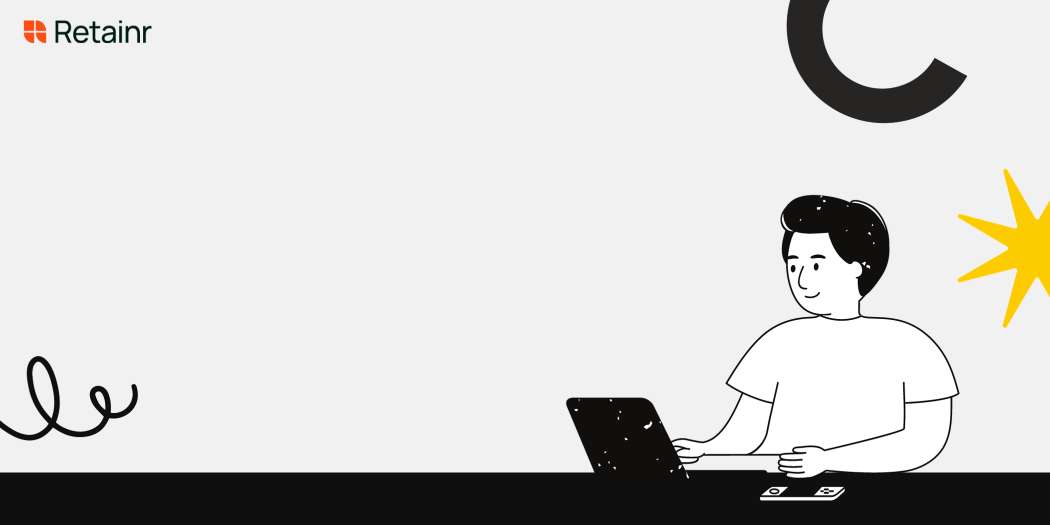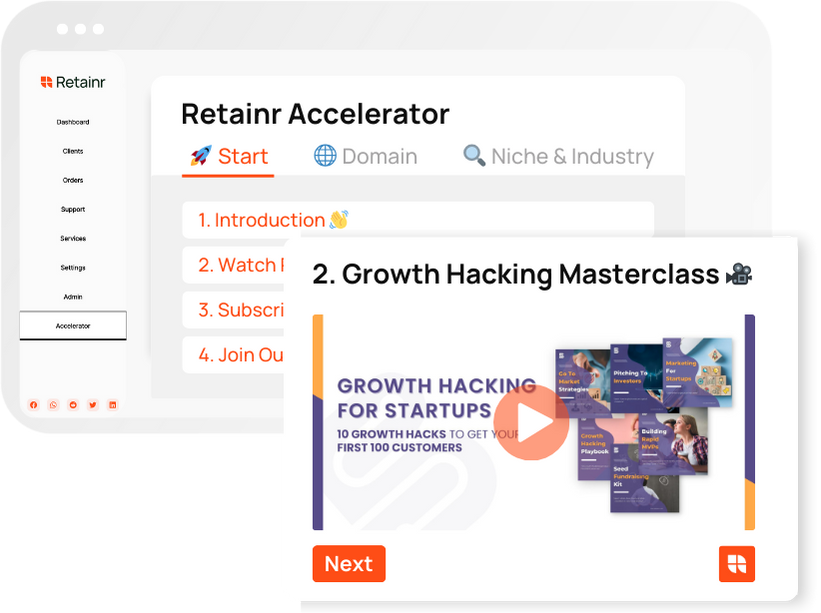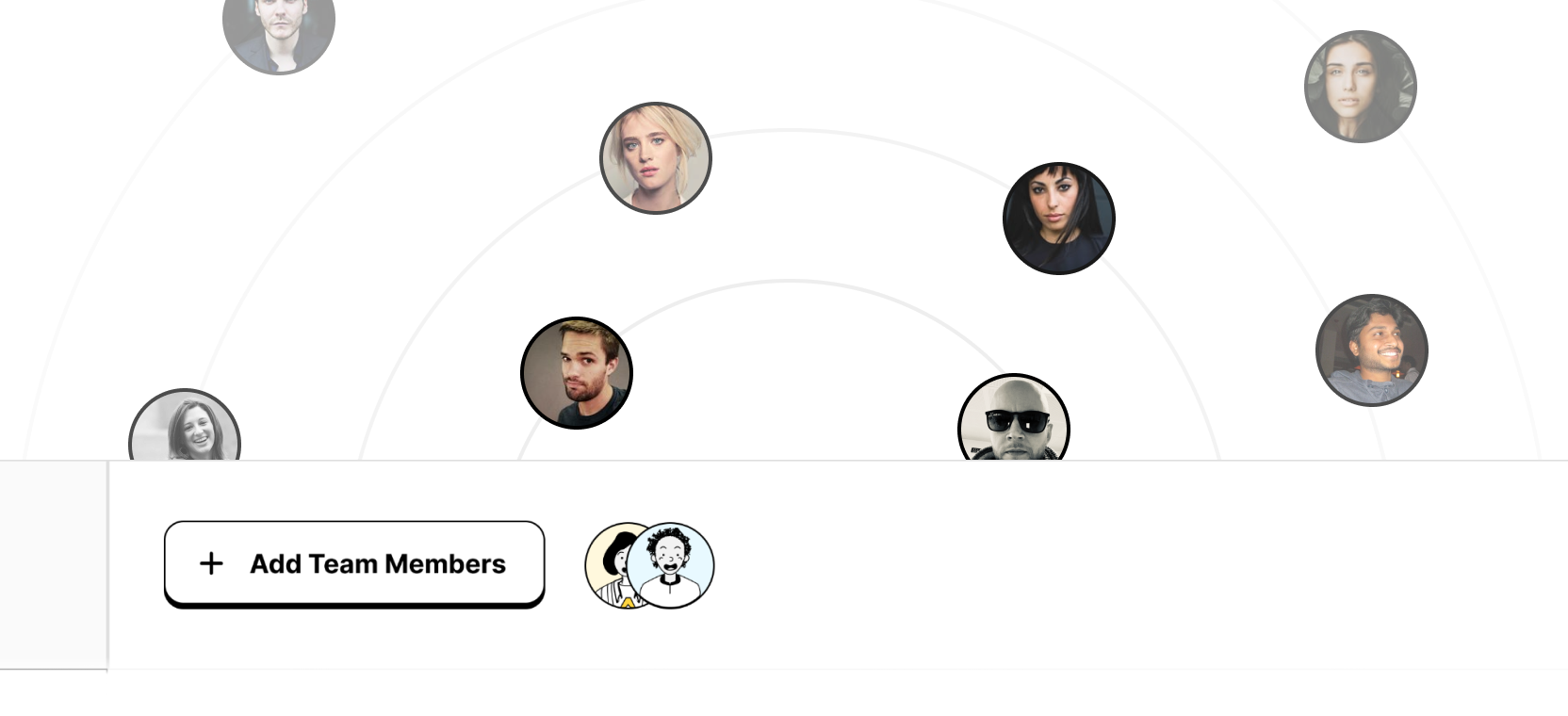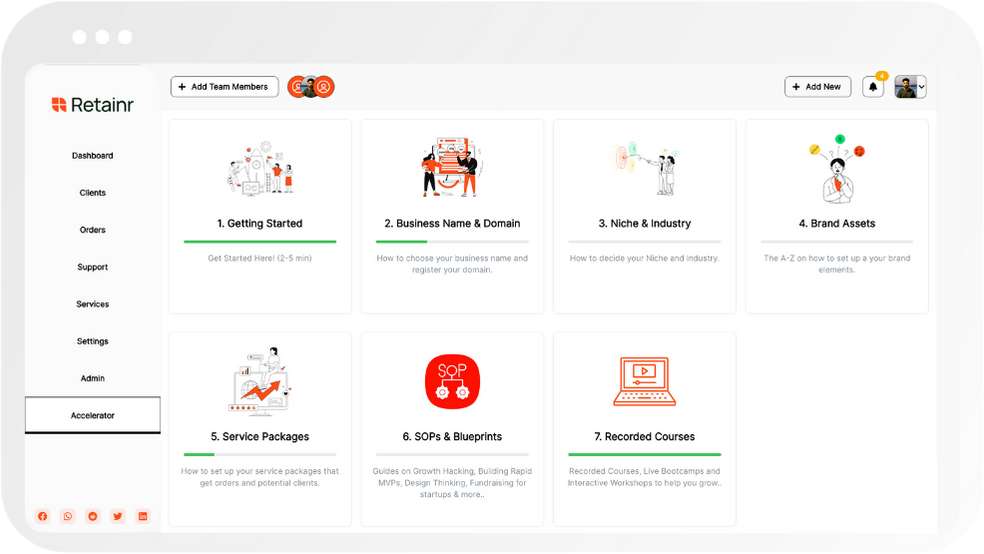
How to Conduct Productive Freelance Client Meetings: 8 Steps
Build with Retainr
Sell your products and services, manage clients, orders, payments, automate your client onboarding and management with your own branded web application.
Get Started1. What are the basic steps to conduct productive freelance client meetings?
Prepare ahead for the meeting
Preparation is the cornerstone for a productive client meeting. The basic steps to consider are:
- Understand the client's needs and objectives
- Research about the client's business
- Create a meeting agenda
- Decide on the meeting platform (if conducting remotely)
Conduct the meeting
Once you've set the groundwork, you're ready to conduct the meeting. The primary steps include:
- Greet the client and engage in small talk to build rapport
- Present the meeting agenda to keep everyone focused
- Listen carefully to the client’s concerns
- Answer their questions thoughtfully and propose solutions
- Document the meeting's key points and follow-ups
After the meeting
What you do after the meeting is as important as the meeting itself. The steps to consider are:
| Step | Description |
|---|---|
| 1 | Provide the client with a summary of the meeting |
| 2 | Specify any action items agreed upon during the meeting |
| 3 | Confirm the next steps and the timeline for their execution |
2. How can I make my freelance client meetings more effective?
Set a Clear Agenda
One of the most effective ways to make your freelance client meetings more productive is by setting a clear agenda beforehand. An agenda provides a roadmap for the meeting, ensuring that all the critical points are discussed. A well-prepared agenda also shows professionalism and respect for the client's time. Points to include in the agenda may be:
- Review of action items from the previous meeting
- Progress update on ongoing projects
- Discussion of new tasks or projects
- Feedback and clarifications
- Next steps and action items for the future
Use Technology
Integrating technology into your meetings can also make them more effective. There are several tools and apps available that can help enhance meeting productivity. Many of these tools offer features such as screen sharing, recording meetings for future reference, digital whiteboards, and real-time collaboration and editing. Here are some tools you may consider:
| Tool | Features | |
|---|---|---|
| Zoom | Video Conferencing, Screen Sharing, Recording | |
| Google Meet | Video Conferencing, Screen Sharing, Real-time Collaboration | |
| Microsoft Teams | Video Conferencing, Collaboration Tools, Digital Whiteboards |
| Category | Action Point |
|---|---|
| Ideas | List them in order of priority |
| Supporting Information | Arrange they follow or support your ideas clearly |
| Presentation | Make sure it flows logically, naturally, and intuitively |
Time Management
Apart from the aforementioned tips, it’s crucial to be mindful of time. For effective time management:
- Ensure that you reach the venue early or log onto the online meeting platform, in case it's a virtual meeting, a few minutes earlier in order to avoid last-minute hiccups.
- Be concise and to the point. Avoid dwelling too much on a single point to prevent boredom and ensure all points are covered.
- Respect the client’s time. If you'd mentioned that the meeting would last only 30 minutes, stick to the schedule.
4. How long should a freelance client meeting typically last for maximum productivity?
Determining the Ideal Duration for Freelance Client Meetings
The duration of freelance client meetings can greatly influence productivity levels. While an exact timeline cannot be universally specified due to varying project complexities and client requirements, there is a general consensus that such meetings should not extend beyond 60 minutes for maximum productivity. Studies suggest that people's attention tends to wane dramatically after this time, therefore, it's crucial to plan accordingly to ensure all important points are discussed within a concise timeframe.
Considerations for Meeting Duration
- Meeting Agenda: Plan your agenda wisely before the meeting, focusing on key objectives. A clearer and more succinct agenda can help keep the meeting within 15 - 30 minutes.
- Status Updates: If the meeting is for project status updates and querying clarifications, it can typically wrap up within 30 minutes.
- Initial Consultations: Initial client meetings or brain-storming sessions may require a full 60 minutes or more to thoroughly understand client expectations and establish a project roadmap.
Comparative Durations of Different Meeting Types
| Meeting Type | Optimal Duration |
|---|---|
| Meeting Agenda | 15-30 minutes |
| Status Updates | 30 minutes |
| Initial Consultations | 60+ minutes |
5. How can I set clear meeting objectives for a freelance client meeting?
Setting Clear Objectives
Setting clear meeting objectives is the key to preparing productive freelance client meetings. There should be a clear purpose and end goal to every discussion to ensure the progress of your projects. Here are some steps to help in setting clear meeting objectives:
- Define Your Goal: What do you want to accomplish with this meeting? It could be discussing the progress of ongoing projects, brainstorming for new ideas, getting client inputs, or addressing specific issues. Define the main aim of your meeting.
- Develop an Agenda: Based on your objectives, develop an agenda outlining what topics will be addressed. Ensure to communicate it to your client ahead of the meeting.
- Communicate Your Expectations: Be clear about what you expect from the client during the meeting. If you need them to make a decision, evaluate something or provide information, let them know in advance.
Importance of Clear Objectives
Creating clear objectives is not just beneficial for you but also for your client. Here’s why:
| Benefit | Description |
|---|---|
| Efficiency | Clear objectives help keep the meeting on track, eliminate unnecessary discussions, and ensure efficient use of time. |
| Effectiveness | With a clear purpose at hand, the meeting can deliver targeted results and decisions, making it more effective. |
| Preparedness | When the client knows what to expect, they can prepare accordingly, leading to more fruitful discussions. |
Implementing Objectives into Actions
Once the meeting objectives are set, they should be implemented into actions to have a productive meeting. Here are some ways to put it into effect:
- Start on Time: Begin the meeting as planned to respect everyone’s time and show professionalism.
- Follow the Agenda: Stick to your outlined agenda to make sure you cover all objectives and don’t stray off-topic.
- Engage Participants: Get your client participating actively to achieve the set objectives. Appreciate their inputs and suggestions.
- Recap and Follow-up: Recap the key decisions and next steps at the end of the meeting. Also, follow up with notes and action items to keep track of progress.
6. What is the importance of setting an agenda for a freelance client meeting?
The Importance of Setting an Agenda
The act of setting an agenda for a freelance client meeting cannot be overlooked because it serves as a road map for the meeting. Without an agenda, meetings can easily veer off track, lose focus, and end up being less productive than they should be. An agenda ensures that all relevant topics are covered within the allocated time.
Here are noteworthy reasons for setting an agenda:
- Focus: Agendas provide a clear focus for the meeting, pinpointing what should be discussed.
- Time management: With an agenda, you can allocate time to each topic, ensuring that nothing is left out and the meeting closes on time.
- Preparation: When participants are aware of the agenda beforehand, they have ample time to prepare, leading to a more productive discussion.
- Control: An agenda allows the meeting leader to regain control of the discussion if it veers off course.
- Record: The agenda can be used as a reference to take meeting minutes and follow up on action items.
| Benefits of Setting an Agenda |
|---|
| It helps keep the meeting focused and engaging |
| Enables better management of time during the meeting |
| Allows participants to prepare beforehand |
| Assists in controlling the meeting's flow |
| Provides a reference point for taking minutes |
In summary, setting an agenda not only optimizes the efficiency of a freelance client meeting but also ensures that all important subjects are addressed. A meticulous and well-thought-out agenda contributes to running a successful and productive meeting.
7. What steps should I take in following up after a freelance client meeting?
Steps to Follow Up After a Freelance Client Meeting
Following up after a client meeting is an essential part of maintaining communication and moving projects forward. Here are a few important steps you should take:
- Send a Thank You Note: Thank your client for their time and mutual engagement in the meeting. It fosters a good relationship and shows a professional attitude.
- Provide a Meeting Summary: Create a summary of the key points and decisions made during the meeting and email it to the client. This ensures that everyone is on the same page.
- Follow-up Tasks: Assign tasks to the appropriate individuals and set deadlines. Make sure that everyone knows what they should be doing next.
- Set Next Meeting Date: If required, schedule your next meeting and confirm the date and time.
Template for Post-Meeting Email
You may utilize the following template to construct an effective follow-up email :
| Subject | [Your Name] Meeting Follow-up [Date] |
| Greeting | Dear [Client's Name], |
| Opening Statement | Thank you for meeting with me on [Date]. I appreciate your time and efforts. |
| Meeting Summary | In our meeting, we discussed…..and agreed to move forward with…. |
| Next Steps | The next steps as we agreed are…..I will update you on my progress by…. |
| Closing Statement | Looking forward to our next meeting scheduled on….. |
Challenges and Solutions in Following Up
Following up might pose certain challenges like timely responses or setting the next meeting date. Here are some strategies to counter these:
- Prompt Action: Act promptly and send the follow-up email within 24 hours of the meeting.
- Manage Expectations: Be clear and specific about what tasks are to be done next.
- Use Reminders: Utilize project management tools or reminders to ensure you stick to deadlines and meetings.
8. How can I manage potential challenges during a freelance client meeting?
Identifying and Managing Potential Challenges
The journey of conducting a freelance client meeting may come with challenges, and understanding how to manage these is crucial for a successful outcome. The potential issues may range from technical glitches to communication hiccups. However, with a clear action plan, you can navigate these hitches effectively.
- Technical problems: Ensure you test all the equipment prior to the meeting, make sure your internet connection is stable, and have a backup plan should there be any technical glitches.
- Running out of time: Adhere to the meeting agenda, be mindful of time during discussions, and ensure that all key points are addressed in a timely manner.
- Client unresponsiveness or lack of engagement: Engage the client by asking questions, seek feedback often, and inspire participation during the meeting.
Mitigating Potential Risks
Managing these challenges is not just about identifying them, but also developing mitigation strategies. A risk mitigation strategy involves planning and acting in advance to either prevent the issue from happening or to reduce its impact.
| Situation | Strategy |
|---|---|
| Technical problems | Having a plan B. For example, if the video conferencing tool fails, be ready to switch to a phone call or another platform. |
| Running out of time | Schedule the meeting well and allocate time for each agenda point. Any topic that cannot be addressed within the time limit will be followed up in separate communications or future meetings. |
| Client unresponsiveness | Keep the meeting interactive. Use visual aids, include question and answer session, and regularly seek client's input or feedback. |
Follow-up Measures
Meeting challenges don’t end immediately after the meeting. Proper follow-up is required to ensure continued progress and to maintain client interest. This can involve sending a thank you note and meeting summary, setting up a subsequent meeting, or getting feedback for improving future sessions.
9. How can I keep the focus of the meeting on the client's needs and goals?
Identify the Client's Needs and Goals
Firstly, it’s essential to know your client's needs and goals beforehand. This will help you to better guide the discussion during the meeting. You can do this by sending out a pre-meeting questionnaire or survey, which should include questions about:
- What do they hope to achieve with the project?
- What challenges are they currently facing?
- What outcomes do they anticipate?
This gives you valuable insight into your client’s expectations and helps to steer the conversation in a productivity-focused direction. Remember, the meeting should always be a platform that promotes a mutual understanding of these ambitions.
Maintain Meeting Focus
There are several ways to maintain focus during a meeting. Firstly, it's important to create and stick to an agenda. Making your client a part of the agenda-setting process is an effective strategy as it promotes involvement and keeps the matters aligned to their needs. Also, employing time management techniques and ensuring discussions stay on track by:
- Respecting everyone's time: Keeping the meeting within the agreed-upon timeframe.
- No distractions: Encouraging everyone to turn off non-emergency notifications.
- Restating main points: Frequently summarizing main points to ensure everyone’s on board.
Establish Next Steps
Lastly, every productive meeting should conclude with a review of decisions made and actions needed before adjourning. This should resonate with the goals and needs initially identified, forming the basis for the concluding part of the meeting, which can be presented in the form of a table:
| Action Items | Responsible Party | Due Date |
|---|---|---|
| Item 1 | John Doe | January 31, 2023 |
| Item 2 | Jane Doe | February 15, 2023 |
This ensures everyone leaves with a clear idea of what is expected of them going forward.
10. How can effective communication be maintained during a freelance client meeting?
Maintaining Effective Communication during Freelance Client Meetings
Several approaches can be implemented to maintain effective communication during a freelance client meeting. These techniques aim to ensure information is delivered and understood as desired. Adherence to these principles typically results in successful and productive meetings.
- Active Listening: Always pay full attention to the client and show interest in what they say. Avoid interruptions and ensure problems are comprehensively understood before proposing solutions.
- Clear and Concise Language: Avoid jargons and high-level languages that may complicate understanding. Your communications should be easy to understand and straight to the point.
- Non-Verbal Communication: Maintain eye contact, adopt appropriate body language, and use visual aids (like charts, graphs) when needed to communicate your points effectively.
The Role of Technology
With the advent of technology, maintaining effective communication during client meetings has been made easier. There are numerous tools that can be used to foster communication and collaboration.
| Tool | Purpose |
|---|---|
| Video Conferencing Tools (Zoom, Skype) | Allows face-to-face interaction with the client regardless of geographical location. |
| Project Management Tools (Asana, Trello) | Help in planning and tracking the progress of the project. |
| Instant Messaging Apps (Slack, Teams) | Provide real-time communication and collaboration amongst team members. |
Feedback and Follow-ups
After any meeting, it is vital to have a feedback mechanism and a follow-up plan in place. It not only ensures everyone is on the same page after the meeting but also allows for the resolution of any lingering issues or concerns.
- Post-Meeting Recap: After the meeting, send out a summary or key points discussed, including the agreed steps and who is responsible for them.
- Open-Ended Questions: Create opportunities for the client to give their input or express concerns. It can be done using open-ended questions that require more than just 'yes' or 'no' answers.
- Regular Check-Ins: Have regular check-ins with the client and update them more frequently about the progress of the project. It helps avoid surprises and manage expectations effectively.
Conclusion
Step 1: Pre-Meeting Preparation
Before you even set foot in the meeting room, there are a number of things you need to do. This includes understanding the purpose of the meeting, defining the meeting goals, and preparing an agenda.
Step 2: Finding the Right Tools
Productive meetings require the right tools. Retainr.io is a powerful white-label software that provides solutions for selling, managing clients, orders, and payments. With your own branded app, it will help streamline the process and enhance productivity.
Step 3: Set Clear Goals and Expectations
Clarify the purpose of the meeting and set clear expectations. This will help avoid misunderstandings and keep everyone focused on the task at hand.
Step 4: Ensure Effective Communication
Communication is key. Keep lines of communication open, be clear and concise, and make sure everyone has a chance to contribute. Communication can also be easily managed and recorded with Retainr.io.
Step 5: Stay Focused on the Agenda
Have a clear agenda and stick to it. This will keep the meeting on track and ensure productive use of time.
Step 6: Encourage Participation
Foster an environment where everyone feels comfortable to participate and share their ideas. This will benefit the meeting by bringing diverse perspectives and ideas to the table.
Step 7: Follow Up and Feedback
After the meeting, make sure to follow up with all participants. Provide feedback, discuss action points, and confirm next steps. Retainr.io allows seamless follow-ups and managing post-meeting tasks with ease.
Step 8: Review and Continuously Improve
Finally, review the effectiveness of your meetings regularly. Look for areas where you could improve, and constantly update your approach to increase productivity. With tools like Retainr.io, conducting productive freelance client meetings will become a breeze.
Boost Your Agency Growth
with Retainr Accelerator
Uncover secrets, strategies, and exclusive blueprints to take your agency's growth to the next level — from marketing insights to effective presentations and leveraging technology.

SOPs, Cheatsheets & Blueprints
Leverage 50+ SOPs (valued over $10K) offering practical guides, scripts, tools, hacks, templates, and cheat sheets to fast-track your startup's growth.
Connect with fellow entrepreneurs, share experiences, and get expert insights within our exclusive Facebook community.
.jpg)

Join a thriving community of growth hackers. Network, collaborate, and learn from like-minded entrepreneurs on a lifelong journey to success.

Gain expertise with recorded Courses, Live Bootcamps and interactive Workshops on topics like growth hacking, copywriting, no-code funnel building, performance marketing and more, taught by seasoned coaches & industry experts.

.jpg)

.jpeg)


